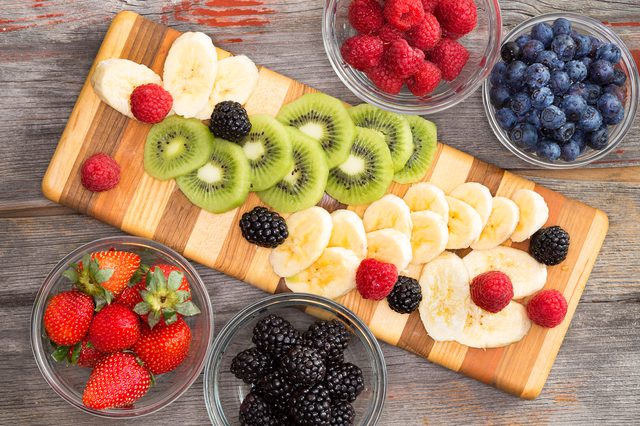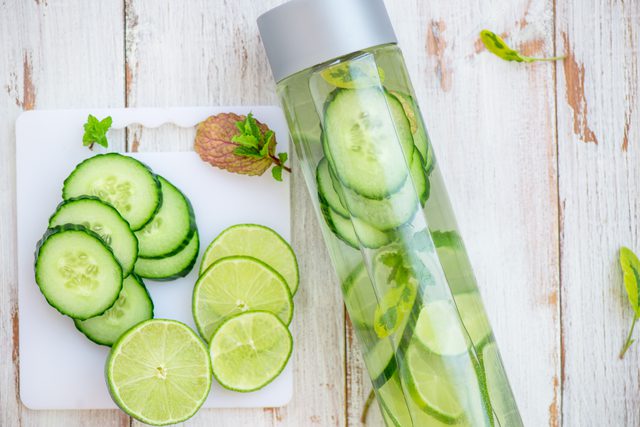
Its like the old saying goes: “By failing to prepare, we are preparing to fail.” This is especially true when it comes to diet. When we don’t give thought to what we’re going to eat during the day, we’re left with what is convenient or close in proximity come mealtime. And the end result? We’re likely to overspend and overeat while not getting any quality nutrition. Here are some top weight-loss meal-prep tips and secrets from the pros to help you reach your goals:
Save Time by Cutting Corners
When you’re just too busy, cut corners to save some time. “For extra-busy people who just don’t want to do meal prep, I recommend buying prepackaged salads and always keeping berries, bananas and spinach in the freezer. You can never go wrong with a salad or a smoothie,” says Samantha Shorkey of Jacked on the Beanstalk. “I also keep low-carb, sprouted Ezekiel wraps in my freezer because they make awesome (and healthy) pizza crusts, hummus dippers and sandwich wraps on the fly.” You can also purchase precut fruits and vegetables for snacking throughout the week.
Put Soup on the Menu
What’s an easy meal that stores well and can help with weight loss? One word: soup! Any time of year, soup is a weight-loss winner you’ll want to keep on your weekly menu. In fact, eating soup may help you manage your weight and whittle your waistline. Allison Schaaf, M.S., RD, founder of meal-planning site PrepDish.com, offers a time-saving tip: “Make a veggie-filled soup and double the recipe. Then freeze half to have later in the month.” In the summer go for cold soups like gazpacho, and in the winter capitalize on filling veggies like turnips, squash and potatoes.
Turn Up the Volume
Trick yourself full by bumping up the volume. “We all know that in order to lose weight we need to consume fewer calories than we burn, which could mean being hungry. Instead of eating tiny food portions, think of ways to create volume without adding a ton of extra calories,” advises Samantha Shorkey of Jacked on the Beanstalk. “You can do this by making veggies the star of every meal. Not only will eating extra veggies make you feel like you’re eating full-size meals, but it’ll also up the fiber and nutritional content. And this can make you feel fuller and not so deprived. Grate some courgettes into your morning oatmeal (you won’t even taste it), or mix cauliflower pieces into your rice at dinner.”
Don’t Always Stick to What You Know
While keeping meal prep simple can be crucial to attaining your weight-loss goals, don’t sell yourself short. According to Beachbody Super Trainer Autumn Calabrese, creator of the best-selling fitness and nutrition program 21 Day Fix, “Making the same three to four things over and over each week can get boring and make you fall off the healthy-food bandwagon.” The key is to add variety without overcomplicating things. “Change up your fruits and veggies with the seasons, and swap out your go-to brown rice for different whole grains, such as millet, buckwheat and quinoa. Experiment with different spices; they add flavor without adding calories. The more variety, the happier your taste buds (and you) will be,” says Calabrese.
Pre-Prep Your Smoothies
Smoothies are an easy way to add nutrients, fiber and protein to your diet as part of your weight-loss journey. “Instead of chopping up fruit each morning, prep your smoothies ahead of time,” says My Nguyen, creator of MyHealthyDish.com. “Wash and remove any peels, cores or husks. Chop to your desired size, and store in single-serving-size portions in a freezer bag. When it’s time to make a smoothie, just pull a bag out of the freezer, add your liquid and protein powder (if you’re going that route) and blend.” Using frozen produce gives the smoothie a thick, indulgent consistency, which means you can skip the ice. “To save even more time, store your prepped smoothie ingredients in a mason jar. You can use the same jar to drink your smoothie,” adds Nguyen.
End Meal-Prep Snacking
If you’re trying to lose weight, you may need to prep for the meal prep. “It can be tempting to eat while you’re in the kitchen prepping for the week. Prep a container of sliced veggies (carrots, peppers, cucumbers, etc.) to have on hand to munch on while cooking. The crunchy raw veggies are satisfying to snack on but low in calories,” says dietitian Lindsay Livingston of Lean Green Bean. Sipping on water or tea may help too.
Tackle Your “Trouble” Meal
When we plan our meal prep, the focus is often on lunch and dinners. “Think beyond dinner and focus on the meals you struggle with, which may include time-crunched breakfasts and midday snacks,” says dietitian Lindsay Livingston of Lean Green Bean. “Starting the day with a healthy, protein-packed breakfast can keep from getting too hungry and overeating at lunchtime. Similarly, having healthy snacks on hand can help you avoid reaching for empty calories from the vending machine when the midday slump hits.”
Infuse Your Water
 We know staying hydrated is a weight-loss tool, but sometimes plain water can get a little boring. “Have a couple of pitchers of your favorite water infusions in the fridge to encourage you to stay hydrated throughout the day — especially during the warmer months of the year,” says registered dietitian nutritionist McKel Hill, founder of Nutrition Stripped and author of her first cookbook, “Nutrition Stripped.” Think of mixed berries and mint or cucumber and honeydew melon. “Many times when you feel hungry your body is actually just thirsty, so stay hydrated to avoid eating more than your body needs,” adds Hill.
We know staying hydrated is a weight-loss tool, but sometimes plain water can get a little boring. “Have a couple of pitchers of your favorite water infusions in the fridge to encourage you to stay hydrated throughout the day — especially during the warmer months of the year,” says registered dietitian nutritionist McKel Hill, founder of Nutrition Stripped and author of her first cookbook, “Nutrition Stripped.” Think of mixed berries and mint or cucumber and honeydew melon. “Many times when you feel hungry your body is actually just thirsty, so stay hydrated to avoid eating more than your body needs,” adds Hill.
Make a List
The first prep step in meal prepping is making your grocery list. “I plan all of my meals in advance and always grocery shop with a list that I do not allow myself to stray from,” shares Samantha Shorkey of Jacked on the Beanstalk. “I like keeping a mini whiteboard in my kitchen to write down any food items I need to pick up. And I sometimes even add motivational quotes to help keep me focused on eating for health.” Make note of portions so you don’t overdo it — falling short on ingredients can put a real cramp in meal planning. Buying in bulk — whole grains, dried fruit, nuts, lentils, etc. — makes it easy to get just the amount you need.
Source: Livestrong.com
Are you interest in instructing Nutrition or Functional Nutrition for sport and exercise? Have a look at our courses here
